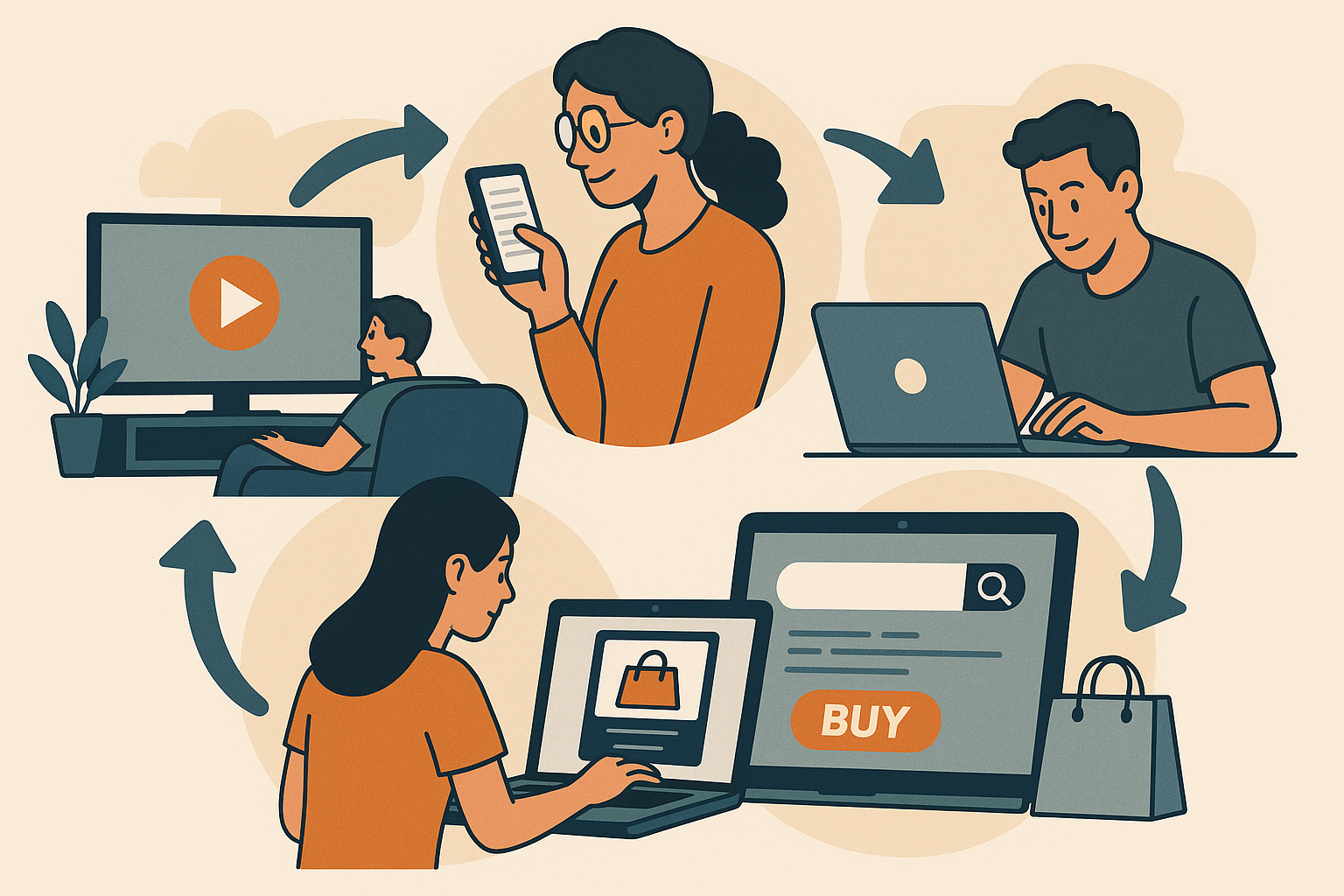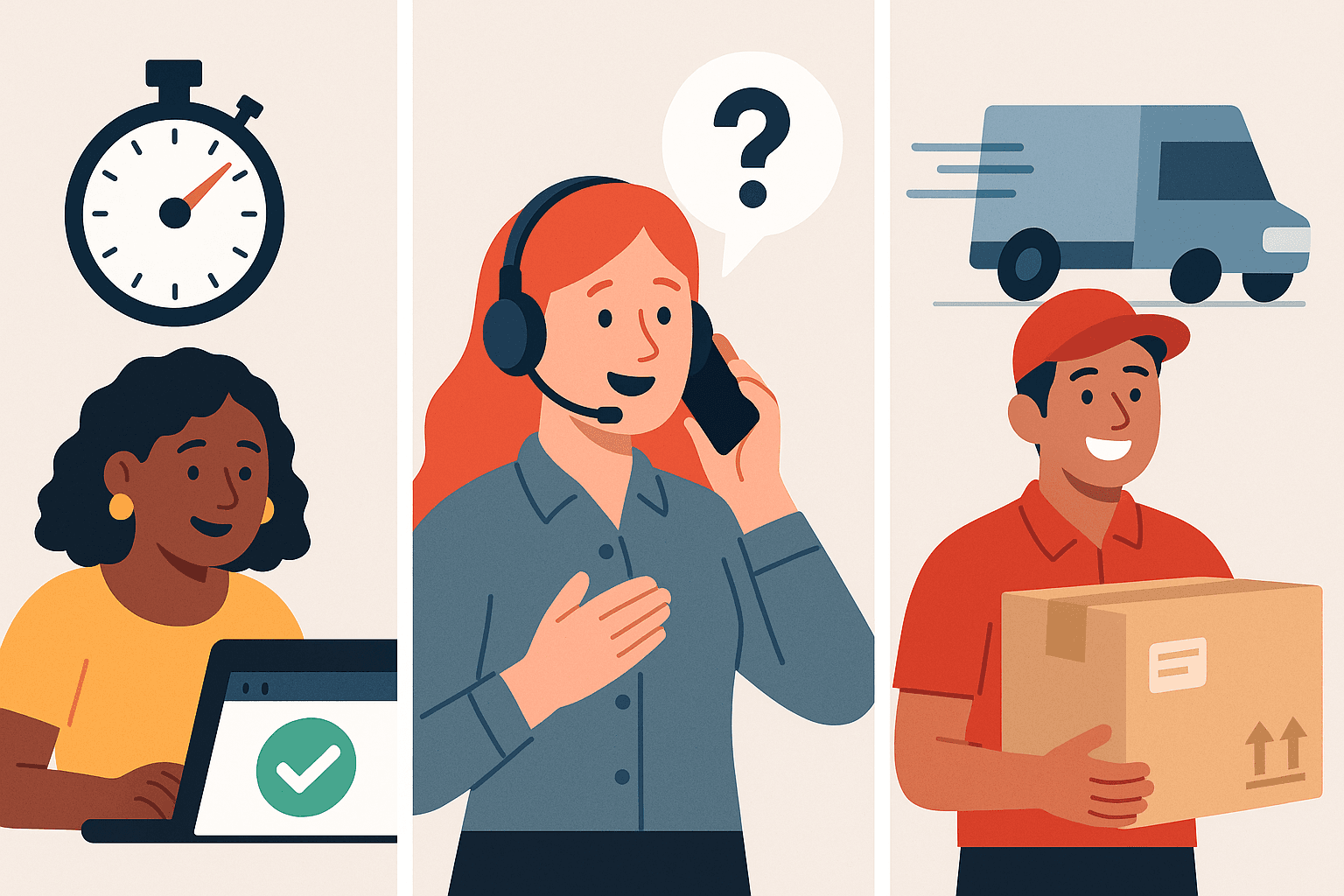Stream, Scroll, Search, Shop: The 4 Habits That Decide What People Buy

TL;DR
- People loop between streaming, scrolling, searching, and shopping. There’s no funnel—just habits that repeat in unpredictable order.
- Each behavior can create or capture demand. Streaming and scrolling spark curiosity; search and shop convert it.
- Sequence creative to reinforce confidence. Every behavior should answer the next question your buyer will have.
Why This Matters Now
The modern customer journey isn’t a funnel—it’s a fidget spinner.
People bounce between apps, tabs, and devices in loops that make old-school marketers cry into their dashboards.
Here’s what’s really happening:
- They stream content (Netflix, YouTube, TikTok) and get inspired.
- They scroll through feeds and stumble on brands.
- They search for proof, prices, and reviews.
- They shop when confidence clicks.
And then? They start again—because new content, trends, or social proof reshapes their intent.
The good news: you can plan for this.
The bad news: only if you stop pretending the journey is linear.
The 4S Framework: A Reality Check for How People Actually Buy
1. Stream: Inspiration on Autoplay
Streaming isn’t just entertainment—it’s discovery in disguise.
The shows we watch, the creators we follow, even the ads we don’t skip—all shape what we think is relevant.
If your brand never appears in streaming contexts, you’re missing the earliest (and least competitive) attention window.
What to do:
- Run short, emotionally clear creative on video platforms—YouTube, Netflix ads, even in-stream audio.
- Focus on emotional “hooks,” not product specs. At this stage, you’re planting seeds, not harvesting clicks.
- Measure recall and search lift, not CTR.
Think of this as the “movie trailer” for your brand story. You’re not selling yet—you’re setting the scene.
2. Scroll: The Spark of Relevance
Scrolling is where attention goes to multitask.
People aren’t looking for you—they’re looking for anything interesting enough to stop the thumb.
Your mission? Earn that pause.
What to do:
- Build creatives that interrupt pattern recognition. Humor, movement, contrast—these stop the scroll.
- Match your message to the platform’s native tone. LinkedIn ≠ TikTok ≠ Instagram.
- Show value instantly. The first two seconds decide everything.
This is where emotion meets repetition: if streaming plants awareness, scrolling builds familiarity.
(Related read: Personalization That Pays)
3. Search: The Moment of Proof
Search is where curiosity becomes commitment—or collapses.
At this stage, users are fact-checking what they’ve seen while streaming or scrolling.
They’re asking:
- “Is it legit?”
- “Who else uses it?”
- “What’s the catch?”
If your SEO or paid search messaging doesn’t match what inspired them upstream, you’ll lose credibility.
What to do:
- Create landing variants tuned to search intent: deal-seekers vs. deep-researchers.
- Use social proof and reviews prominently—don’t bury them in subpages.
- Ensure your snippet language mirrors ad language to maintain narrative consistency.
In short: search is where confidence compounds—or evaporates.
(Related read: Sequence to Win: Video First or Search First?)
4. Shop: The Proof of Promise
The shopping moment is less about checkout UX and more about confirmation bias.
People want to feel that buying from you is the logical outcome of their journey, not a leap of faith.
What to do:
- Make checkout frictionless. Every extra field equals a drop in dopamine.
- Reinforce reassurance cues: free returns, delivery clarity, trusted payments.
- Use thank-you pages to keep momentum—“Customers who bought this also loved…” isn’t just upsell; it’s reassurance.
When you optimize checkout speed, support clarity, and delivery transparency, you’re not just reducing friction—you’re marketing competence.
(Related read: Speed Is a Feature: Site, Support, and Delivery That Convert)
Why Funnels Fail, But Behaviors Don’t
The funnel assumes awareness → consideration → decision → loyalty.
But the real world doesn’t behave that politely.
Consumers now treat channels as parallel windows into the same question: “Can I trust this?”
They stream to feel inspired, scroll to feel connected, search to feel informed, and shop to feel safe.
Your marketing should mirror that emotional progression—not the PowerPoint one.
What to Do This Month
-
Map your 4S behaviors.
Take your top 3 customer journeys and plot where each habit shows up.
Example: your skincare brand might spark via scroll (TikTok), validate via search, and close via shop. -
Build modular creative.
Create 3–5 message variants per habit.
Use consistent visuals but adapt tone—educational for stream, playful for scroll, specific for search, reassuring for shop. -
Align media and measurement.
- Stream/Scroll → Track attention and search lift.
- Search/Shop → Track incremental conversions and time to decision.
-
Bridge creative gaps.
If your search ad and video don’t sound like they come from the same brand, fix that first.
Evidence & Caveats
Think with Google’s global behavior studies confirm the rise of the “4S loop.”
The same person might move through all four modes in one sitting—and switch devices mid-way.
McKinsey’s research on omnichannel journeys supports this too: performance peaks when brand messages are sequenced across behaviors, not repeated mindlessly.
Caveat: Measuring across 4S behaviors requires a mixed stack—ad data, search logs, CRM, and holdouts.
If you only look at last-click data, you’ll end up optimizing for the smallest part of the loop.
FAQs & Objections
Do I need separate creatives for each behavior?
Yes, but not separate campaigns.
Think modular, not massive. One video can spawn cut-downs for scroll and proof assets for search.
Isn’t this just “omnichannel”?
Not quite. Omnichannel is where you reach people; 4S is how they behave once you do.
What if my budget’s small?
Then pick two behaviors that matter most—usually scroll + search—and master sequencing there first.
Does this apply to B2B?
Absolutely. B2B buyers stream webinars, scroll LinkedIn, search for proof, and shop by form-filling. The psychology’s the same.
Key Takeaway: Design for Human Rhythms, Not Linear Paths
Your audience doesn’t follow your funnel—they follow their habits.
If you can understand and design around the 4S loop, you’ll move from chasing clicks to shaping confidence.
Streaming sparks imagination.
Scrolling builds relevance.
Search proves value.
Shopping seals the deal.
Everything else is just noise between scrolls.
(And if your next campaign plan still has “Top of Funnel / Bottom of Funnel” on the slide… consider renaming it “Top of Reality.”)
Read similar content
Similar topics

Speed Is a Feature: Site, Support, and Delivery That Convert
Operational speed—page loads, helpful support, clear delivery—now decides who wins the cart.

Loyalty That Changes Behavior (Not Just Points)
Design rewards and service advantages that make people act differently—return more, spend more, advocate more.